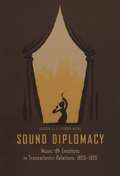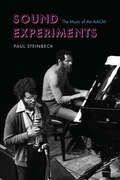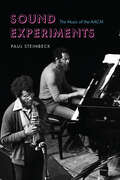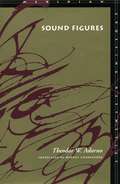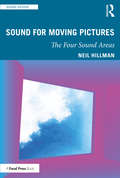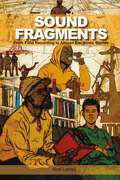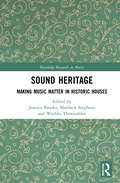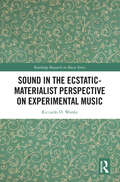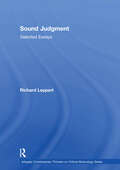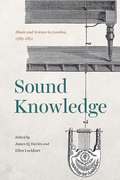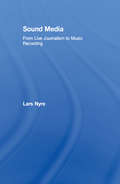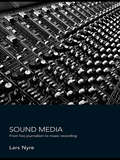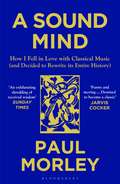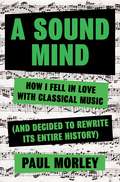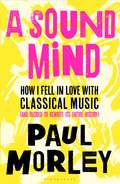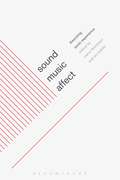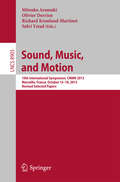- Table View
- List View
Sound Diplomacy: Music and Emotions in Transatlantic Relations, 1850-1920
by Jessica C. Gienow-HechtThe German-American relationship was special long before the Cold War; it was rooted not simply in political actions, but also long-term traditions of cultural exchange that date back to the nineteenth century. Between 1850 and 1910, the United States was a rising star in the international arena, and several European nations sought to strengthen their ties to the republic by championing their own cultures in America. While France capitalized on its art and Britain on its social ties and literature, Germany promoted its particular breed of classical music. Delving into a treasure trove of archives that document cross-cultural interactions between America and Germany, Jessica Gienow-Hecht retraces these efforts to export culture as an instrument of nongovernmental diplomacy, paying particular attention to the role of conductors, and uncovers the remarkable history of the musician as a cultural symbol of German cosmopolitanism. Considered sexually attractive and emotionally expressive, German players and conductors acted as an army of informal ambassadors for their home country, and Gienow-Hecht argues that their popularity in the United States paved the way for an emotional elective affinity that survived broken treaties and several wars and continues to the present.
Sound Experiments: The Music of the AACM
by Paul SteinbeckA groundbreaking study of the trailblazing music of Chicago’s AACM, a leader in the world of jazz and experimental music. Founded on Chicago’s South Side in 1965 and still thriving today, the Association for the Advancement of Creative Musicians (AACM) is the most influential collective organization in jazz and experimental music. In Sound Experiments, Paul Steinbeck offers an in-depth historical and musical investigation of the collective, analyzing individual performances and formal innovations in captivating detail. He pays particular attention to compositions by Muhal Richard Abrams and Roscoe Mitchell, the Association’s leading figures, as well as Anthony Braxton, George Lewis (and his famous computer-music experiment, Voyager), Wadada Leo Smith, and Henry Threadgill, along with younger AACM members such as Mike Reed, Tomeka Reid, and Nicole Mitchell. Sound Experiments represents a sonic history, spanning six decades, that affords insight not only into the individuals who created this music but also into an astonishing collective aesthetic. This aesthetic was uniquely grounded in nurturing communal ties across generations, as well as a commitment to experimentalism. The AACM’s compositions broke down the barriers between jazz and experimental music and made essential contributions to African American expression more broadly. Steinbeck shows how the creators of these extraordinary pieces pioneered novel approaches to instrumentation, notation, conducting, musical form, and technology, creating new soundscapes in contemporary music.
Sound Experiments: The Music of the AACM
by Paul SteinbeckA groundbreaking study of the trailblazing music of Chicago’s AACM, a leader in the world of jazz and experimental music. Founded on Chicago’s South Side in 1965 and still thriving today, the Association for the Advancement of Creative Musicians (AACM) is the most influential collective organization in jazz and experimental music. In Sound Experiments, Paul Steinbeck offers an in-depth historical and musical investigation of the collective, analyzing individual performances and formal innovations in captivating detail. He pays particular attention to compositions by Muhal Richard Abrams and Roscoe Mitchell, the Association’s leading figures, as well as Anthony Braxton, George Lewis (and his famous computer-music experiment, Voyager), Wadada Leo Smith, and Henry Threadgill, along with younger AACM members such as Mike Reed, Tomeka Reid, and Nicole Mitchell. Sound Experiments represents a sonic history, spanning six decades, that affords insight not only into the individuals who created this music but also into an astonishing collective aesthetic. This aesthetic was uniquely grounded in nurturing communal ties across generations, as well as a commitment to experimentalism. The AACM’s compositions broke down the barriers between jazz and experimental music and made essential contributions to African American expression more broadly. Steinbeck shows how the creators of these extraordinary pieces pioneered novel approaches to instrumentation, notation, conducting, musical form, and technology, creating new soundscapes in contemporary music.
Sound Figures (Meridian: Crossing Aesthetics)
by Theodor W. AdornoTheodor Adorno is one of this century's most influential thinkers in the areas of social theory, philosophy, aesthetics, and music. Throughout the essays in this book, all of which concern musical matters, he displays an astonishing range of cultural reference, demonstrating that music is invariably social, political, even ethical. Adorno's insistence on the social character of aesthetic works will come as no surprise to those familiar with his writings, although many may be surprised by the volume's somewhat colloquial tone. This colloquialism, in dialogue with Adorno's unceasing rigor, stems from the occasional sources of many of the essays, mainly public lectures and radio addresses. As such, this volume represents an important and, for English-language readers, largely unfamiliar side to Adorno. His arguments move more quickly than in his more formal and extended musicological works, and the writing is much more accessible and generous than his usually dense and frequently opaque prose. This volume includes essays on prominent figures in music (Alban Berg, Anton von Webern, Arturo Toscanini), compositional technique (the prehistory of the twelve-tone row, the function of counterpoint in new music), and the larger questions of musical sociology for which Adorno is most famous, including the relation of interpretation to audience, the ideological function of opera, and the historical meaning of musical technique. The essay on the sociology of music, for example, represents an early statement of what would soon become trademark principles of his mode of musical analysis, serving as a catalyst for his famous study Introduction to the Sociology of Music. Some forty years after most of these essays were written, they remain fresh and relevant. In part, this is because Adorno's method has only recently begun to make substantial inroads into Anglo-American musicology. And the interdisciplinary nature of his thought provides a precursor for today's interdisciplinary studies.
Sound for Moving Pictures: The Four Sound Areas (Sound Design)
by Neil HillmanSound for Moving Pictures presents a new and original sound design theory called the Four Sound Areas framework, offering a conceptual template for constructing, deconstructing and communicating all types of motion picture soundtracks; and a way for academics and practitioners to better understand and utilize the deeper, emotive capabilities available to all filmmakers through the thoughtful use of sound design. The Four Sound Areas framework presents a novel approach to sound design that enables the reader to more fully appreciate audience emotions and audience engagement, and provides a flexible, practical model that will allow professionals to more easily create and communicate soundtracks with greater emotional significance and meaning. Of obvious benefit to sound specialists, as well as motion picture professionals such as film producers, directors and picture editors, Sound for Moving Pictures also provides valuable insight for others interested in the subject; such as those involved with teaching soundtrack analysis, or those researching the wider topics of film studies and screen writing.
Sound for Moving Pictures: The Four Sound Areas (Sound Design)
by Neil HillmanSound for Moving Pictures presents a new and original sound design theory called the Four Sound Areas framework, offering a conceptual template for constructing, deconstructing and communicating all types of motion picture soundtracks; and a way for academics and practitioners to better understand and utilize the deeper, emotive capabilities available to all filmmakers through the thoughtful use of sound design. The Four Sound Areas framework presents a novel approach to sound design that enables the reader to more fully appreciate audience emotions and audience engagement, and provides a flexible, practical model that will allow professionals to more easily create and communicate soundtracks with greater emotional significance and meaning. Of obvious benefit to sound specialists, as well as motion picture professionals such as film producers, directors and picture editors, Sound for Moving Pictures also provides valuable insight for others interested in the subject; such as those involved with teaching soundtrack analysis, or those researching the wider topics of film studies and screen writing.
Sound Fragments: From Field Recording to African Electronic Stories (Music / Culture)
by Noel LobleyThis book is an ethnographic study of sound archives and the processes of creative decolonization that form alternative modes of archiving and curating in the 21st century. It explores the histories and afterlives of sound collections and practices at the International Library of African Music. Sound Fragments follows what happens when a colonial sound archive is repurposed and reimagined by local artists in post-apartheid South Africa. The narrative speaks to larger issues in sound studies, curatorial practices, and the reciprocity and ethics of listening to and reclaiming culture. Sound Fragments interrogates how Xhosa arts activism contributes to an expanding notion of what a sound or cultural archive could be, and where it may resonate now and in future.
Sound Heritage: Making Music Matter in Historic Houses (Routledge Research in Music)
by Jeanice Brooks Matthew Stephens Wiebke ThormählenSound Heritage is the first study of music in the historic house museum, featuring contributions from both music and heritage scholars and professionals in a richly interdisciplinary approach to central issues. It examines how music materials can be used to create narratives about past inhabitants and their surroundings - including aspects of social and cultural life beyond the activity of music making itself - and explores how music as sound, material, and practice can be more consistently and engagingly integrated into the curation and interpretation of historic houses. The volume is structured around a selection of thematic chapters and a series of shorter case studies, each focusing on a specific house, object or project. Key themes include: Different types of historic house, including the case of the composer or musician house; what can be learned from museums and galleries about the use of sound and music and what may not transfer to the historic house setting Musical instruments as part of a wider collection; questions of restoration and public use; and the demands of particular collection types such as sheet music Musical objects and pieces of music as storytelling components, and the use of music to affectively colour narratives or experiences. This is a pioneering study that will appeal to all those interested in the intersection between Music and Museum and Heritage Studies. It will also be of interest to scholars and researchers of Music History, Popular Music, Performance Studies and Material Culture.
Sound Heritage: Making Music Matter in Historic Houses (Routledge Research in Music)
by Jeanice Brooks Matthew Stephens Wiebke ThormählenSound Heritage is the first study of music in the historic house museum, featuring contributions from both music and heritage scholars and professionals in a richly interdisciplinary approach to central issues. It examines how music materials can be used to create narratives about past inhabitants and their surroundings - including aspects of social and cultural life beyond the activity of music making itself - and explores how music as sound, material, and practice can be more consistently and engagingly integrated into the curation and interpretation of historic houses. The volume is structured around a selection of thematic chapters and a series of shorter case studies, each focusing on a specific house, object or project. Key themes include: Different types of historic house, including the case of the composer or musician house; what can be learned from museums and galleries about the use of sound and music and what may not transfer to the historic house setting Musical instruments as part of a wider collection; questions of restoration and public use; and the demands of particular collection types such as sheet music Musical objects and pieces of music as storytelling components, and the use of music to affectively colour narratives or experiences. This is a pioneering study that will appeal to all those interested in the intersection between Music and Museum and Heritage Studies. It will also be of interest to scholars and researchers of Music History, Popular Music, Performance Studies and Material Culture.
Sound in the Ecstatic-Materialist Perspective on Experimental Music (Routledge Research in Music)
by Riccardo D. WankeWhat does a one hour contemporary orchestral piece by Georg Friedrich Haas have in common with a series of glitch-noise electronic tracks by Pan Sonic? This book proposes that, despite their differences, they share a particular understanding of sound that is found across several quite distinct genres of contemporary art music: the ecstatic-materialist perspective. Sound in the ecstatic-materialist perspective is considered as a material mass or element, unfolding in time, encountered by a listener, for whom the experience of that sound exceeds the purely sonic without becoming entirely divorced from its materiality. It is "material" by virtue of the focus on the texture, consistency, and density of sound; it is "ecstatic" in the etymological sense, that is to say that the experience of this sound involves an instability; an inclination to depart from material appearance, an ephemeral and transitory impulse in the very perception of sound to something beyond – but still related to – it. By examining musical pieces from spectralism to electroacoustic domains, from minimalism to glitch electronica and dubstep, this book identifies the key intrinsic characteristics of this musical perspective. To fully account for this perspective on sonic experience, listener feedback and interviews with composers and performers are also incorporated. Sound in the ecstatic-materialist perspective is the common territory where composers, sound artists, performers, and listeners converge.
Sound in the Ecstatic-Materialist Perspective on Experimental Music (Routledge Research in Music)
by Riccardo D. WankeWhat does a one hour contemporary orchestral piece by Georg Friedrich Haas have in common with a series of glitch-noise electronic tracks by Pan Sonic? This book proposes that, despite their differences, they share a particular understanding of sound that is found across several quite distinct genres of contemporary art music: the ecstatic-materialist perspective. Sound in the ecstatic-materialist perspective is considered as a material mass or element, unfolding in time, encountered by a listener, for whom the experience of that sound exceeds the purely sonic without becoming entirely divorced from its materiality. It is "material" by virtue of the focus on the texture, consistency, and density of sound; it is "ecstatic" in the etymological sense, that is to say that the experience of this sound involves an instability; an inclination to depart from material appearance, an ephemeral and transitory impulse in the very perception of sound to something beyond – but still related to – it. By examining musical pieces from spectralism to electroacoustic domains, from minimalism to glitch electronica and dubstep, this book identifies the key intrinsic characteristics of this musical perspective. To fully account for this perspective on sonic experience, listener feedback and interviews with composers and performers are also incorporated. Sound in the ecstatic-materialist perspective is the common territory where composers, sound artists, performers, and listeners converge.
Sound Judgment: Selected Essays (Ashgate Contemporary Thinkers On Critical Musicology Ser.)
by Richard LeppertThe essays in Sound Judgment span the full career of Richard Leppert, from his earliest to work that appears here for the first time, on subjects drawn from early modernity to the present concerning music both popular and classical, European and North American. Noted for his path-breaking interdisciplinary scholarship on music and visual culture, the collection includes key essays on music's visualization in art practices in virtually all visual media, including film. The fourteen essays comprising this volume demonstrate Leppert's many contributions to critical musicology, particularly in the areas of aesthetics as well as social and intellectual history, all of it grounded in a heterodox body of critical and cultural theory, with the work of Theodor W. Adorno particularly noteworthy. The collection is preceded by an introduction in which Leppert traces his intellectual development, defined in large part by the social, cultural, and political upheavals of the 1960s and their aftermath both in the academy and in society at large.
Sound Judgment: Selected Essays (Ashgate Contemporary Thinkers On Critical Musicology Ser.)
by Richard LeppertThe essays in Sound Judgment span the full career of Richard Leppert, from his earliest to work that appears here for the first time, on subjects drawn from early modernity to the present concerning music both popular and classical, European and North American. Noted for his path-breaking interdisciplinary scholarship on music and visual culture, the collection includes key essays on music's visualization in art practices in virtually all visual media, including film. The fourteen essays comprising this volume demonstrate Leppert's many contributions to critical musicology, particularly in the areas of aesthetics as well as social and intellectual history, all of it grounded in a heterodox body of critical and cultural theory, with the work of Theodor W. Adorno particularly noteworthy. The collection is preceded by an introduction in which Leppert traces his intellectual development, defined in large part by the social, cultural, and political upheavals of the 1960s and their aftermath both in the academy and in society at large.
Sound Knowledge: Music and Science in London, 1789-1851
by James Q. Davies Ellen LockhartWhat does it mean to hear scientifically? What does it mean to see musically? This volume uncovers a new side to the long nineteenth century in London, a hidden history in which virtuosic musical entertainment and scientific discovery intersected in remarkable ways. Sound Knowledge examines how scientific truth was accrued by means of visual and aural experience, and, in turn, how musical knowledge was located in relation to empirical scientific practice. James Q. Davies and Ellen Lockhart gather work by leading scholars to explore a crucial sixty-year period, beginning with Charles Burney’s ambitious General History of Music, a four-volume study of music around the globe, and extending to the Great Exhibition of 1851, where musical instruments were assembled alongside the technologies of science and industry in the immense glass-encased collections of the Crystal Palace. Importantly, as the contributions show, both the power of science and the power of music relied on performance, spectacle, and experiment. Ultimately, this volume sets the stage for a new picture of modern disciplinarity, shining light on an era before the division of aural and visual knowledge.
Sound Knowledge: Music and Science in London, 1789-1851
by James Q. Davies and Ellen Lockhart Ellen LockhartWhat does it mean to hear scientifically? What does it mean to see musically? This volume uncovers a new side to the long nineteenth century in London, a hidden history in which virtuosic musical entertainment and scientific discovery intersected in remarkable ways. Sound Knowledge examines how scientific truth was accrued by means of visual and aural experience, and, in turn, how musical knowledge was located in relation to empirical scientific practice. James Q. Davies and Ellen Lockhart gather work by leading scholars to explore a crucial sixty-year period, beginning with Charles Burney’s ambitious General History of Music, a four-volume study of music around the globe, and extending to the Great Exhibition of 1851, where musical instruments were assembled alongside the technologies of science and industry in the immense glass-encased collections of the Crystal Palace. Importantly, as the contributions show, both the power of science and the power of music relied on performance, spectacle, and experiment. Ultimately, this volume sets the stage for a new picture of modern disciplinarity, shining light on an era before the division of aural and visual knowledge.
Sound Knowledge: Music and Science in London, 1789-1851
by James Q. Davies and Ellen Lockhart Ellen LockhartWhat does it mean to hear scientifically? What does it mean to see musically? This volume uncovers a new side to the long nineteenth century in London, a hidden history in which virtuosic musical entertainment and scientific discovery intersected in remarkable ways. Sound Knowledge examines how scientific truth was accrued by means of visual and aural experience, and, in turn, how musical knowledge was located in relation to empirical scientific practice. James Q. Davies and Ellen Lockhart gather work by leading scholars to explore a crucial sixty-year period, beginning with Charles Burney’s ambitious General History of Music, a four-volume study of music around the globe, and extending to the Great Exhibition of 1851, where musical instruments were assembled alongside the technologies of science and industry in the immense glass-encased collections of the Crystal Palace. Importantly, as the contributions show, both the power of science and the power of music relied on performance, spectacle, and experiment. Ultimately, this volume sets the stage for a new picture of modern disciplinarity, shining light on an era before the division of aural and visual knowledge.
Sound Knowledge: Music and Science in London, 1789-1851
What does it mean to hear scientifically? What does it mean to see musically? This volume uncovers a new side to the long nineteenth century in London, a hidden history in which virtuosic musical entertainment and scientific discovery intersected in remarkable ways. Sound Knowledge examines how scientific truth was accrued by means of visual and aural experience, and, in turn, how musical knowledge was located in relation to empirical scientific practice. James Q. Davies and Ellen Lockhart gather work by leading scholars to explore a crucial sixty-year period, beginning with Charles Burney’s ambitious General History of Music, a four-volume study of music around the globe, and extending to the Great Exhibition of 1851, where musical instruments were assembled alongside the technologies of science and industry in the immense glass-encased collections of the Crystal Palace. Importantly, as the contributions show, both the power of science and the power of music relied on performance, spectacle, and experiment. Ultimately, this volume sets the stage for a new picture of modern disciplinarity, shining light on an era before the division of aural and visual knowledge.
Sound Media: From Live Journalism to Music Recording
by Lars NyreSound Media considers how music recording, radio broadcasting and muzak influence people's daily lives and introduces the many and varied creative techniques that have developed in music and journalism throughout the twentieth century. Lars Nyre starts with the contemporary cultures of sound media, and works back to the archaic soundscapes of the 1870s. The first part of the book devotes five chapters to contemporary digital media, and presents the internet, the personal computer, digital radio (news and talk) and various types of loudspeaker media (muzak, DJ-ing, clubbing and PA systems). The second part examines the historical accumulation of techniques and sounds in sound media, and presents multitrack music in the 1960s, the golden age of radio in the 1950s and back to the 1930s, microphone recording of music in the 1930s, the experimental phase of wireless radio in the 1910s and 1900s, and the invention of the gramophone and phonograph in the late nineteenth century. Sound Media includes a soundtrack CD with thirty-six examples from broadcasting and music recording in Europe and the USA, from Edith Piaf to Sarah Cox, and is richly illustrated with figures, timelines and technical drawings.
Sound Media: From Live Journalism to Music Recording
by Lars NyreSound Media considers how music recording, radio broadcasting and muzak influence people's daily lives and introduces the many and varied creative techniques that have developed in music and journalism throughout the twentieth century. Lars Nyre starts with the contemporary cultures of sound media, and works back to the archaic soundscapes of the 1870s. The first part of the book devotes five chapters to contemporary digital media, and presents the internet, the personal computer, digital radio (news and talk) and various types of loudspeaker media (muzak, DJ-ing, clubbing and PA systems). The second part examines the historical accumulation of techniques and sounds in sound media, and presents multitrack music in the 1960s, the golden age of radio in the 1950s and back to the 1930s, microphone recording of music in the 1930s, the experimental phase of wireless radio in the 1910s and 1900s, and the invention of the gramophone and phonograph in the late nineteenth century. Sound Media includes a soundtrack CD with thirty-six examples from broadcasting and music recording in Europe and the USA, from Edith Piaf to Sarah Cox, and is richly illustrated with figures, timelines and technical drawings.
A Sound Mind: How I Fell in Love with Classical Music (and Decided to Rewrite its Entire History)
by Paul Morley'An alternately funny and moving book about the most important art form on Planet Earth. Destined to become a classic (pun intended)' Jarvis CockerMusic critic and writer Paul Morley weaves together memoir and history in a spiralling tale that establishes classical music as the most rebellious genre of all. Paul Morley had stopped being surprised by modern pop music and found himself retreating into the sounds of artists he loved when, as an emerging music journalist in the 70s, he wrote for NME. But not wishing to give in to dreary nostalgia, endlessly circling back to the bands he wrote about in the past, he went searching for something new, rare and wondrous – and found it in classical music. A soaring polemic, a grumpy reflection on modern rock, and a fan's love note, A Sound Mind rejects the idea that classical music is establishment; old; a drag. Instead, the book reveals this genre to be the most exciting and varied in music. A Sound Mind is a multi-layered memoir of Morley's shifting musical tastes, but it is also a compelling history of classical music that reveals the genre's rich and often deviant past – and, hopefully, future. Like a conductor, Morley weaves together timelines and timeframes in an orchestral narrative that declares the transformative and resilient power of classical music from Bach to Shostakovich, Brahms to Birtwistle, Mozart to Cage, travelling from eighteenth century salons to the modern age of Spotify.
A Sound Mind: How I Fell in Love with Classical Music (and Decided to Rewrite its Entire History)
by Paul MorleyFor readers of Mozart in the Jungle and Year of Wonder, a new history of and guide to classical music. Paul Morley made his name as a journalist covering the rock and pop of the 1970s and 1980s. But as his career progressed, he found himself drawn toward developing technologies, streaming platforms, and, increasingly, the music from the past that streaming services now made available. Suddenly able to access every piece Mozart or Bach had ever written and to curate playlists that worked with these musicians' themes across different performers, composers, and eras, he began to understand classical music in a whole new way and to believe that it was music at its most dramatic and revealing. In A Sound Mind, Morley takes readers along on his journey into the history and future of classical music. His descriptions, explanations, and guidance make this seemingly arcane genre more friendly to listeners and show the music's power, depth, and timeless beauty. In Morley's capable hands, the history of the classical genre is shown to be the history of all music, with these long-ago pieces influencing everyone from jazz greats to punk rockers and the pop musicians of today.
A Sound Mind: How I Fell in Love with Classical Music (and Decided to Rewrite its Entire History)
by Paul Morley'An alternately funny and moving book about the most important art form on Planet Earth. Destined to become a classic (pun intended)' Jarvis CockerMusic critic and writer Paul Morley weaves together memoir and history in a spiralling tale that establishes classical music as the most rebellious genre of all. Paul Morley had stopped being surprised by modern pop music and found himself retreating into the sounds of artists he loved when, as an emerging music journalist in the 70s, he wrote for NME. But not wishing to give in to dreary nostalgia, endlessly circling back to the bands he wrote about in the past, he went searching for something new, rare and wondrous – and found it in classical music. A soaring polemic, a grumpy reflection on modern rock, and a fan's love note, A Sound Mind rejects the idea that classical music is establishment; old; a drag. Instead, the book reveals this genre to be the most exciting and varied in music. A Sound Mind is a multi-layered memoir of Morley's shifting musical tastes, but it is also a compelling history of classical music that reveals the genre's rich and often deviant past – and, hopefully, future. Like a conductor, Morley weaves together timelines and timeframes in an orchestral narrative that declares the transformative and resilient power of classical music from Bach to Shostakovich, Brahms to Birtwistle, Mozart to Cage, travelling from eighteenth century salons to the modern age of Spotify.
Sound, Music, Affect: Theorizing Sonic Experience
by Ian Biddle Marie ThompsonSound, Music, Affect features brand new essays that bring together the burgeoning developments in sound studies and affect studies. The first section sets out key methodological and theoretical concerns, focussing on the relationships between affective models and sound. The second section deals with particular musical case studies, exploring how reference to affect theory might change or reshape some of the ways we are able to make sense of musical materials. The third section examines the politics and practice of sonic disruption: from the notion of noise as 'prophecy', to the appropriation of 'bad vibes' for pleasurable aesthetic and affective experiences. And the final section engages with some of the ways in which affect can help us understand the politics of chill, relaxation and intimacy as sonic encounters. The result is a rich and multifaceted consideration of sound, music and the affective, from scholars with backgrounds in cultural theory, history, literary studies, media studies, architecture, philosophy and musicology.
Sound, Music, Affect: Theorizing Sonic Experience
by MARIE THOMPSON AND IAN BIDDLESound, Music, Affect features brand new essays that bring together the burgeoning developments in sound studies and affect studies. The first section sets out key methodological and theoretical concerns, focussing on the relationships between affective models and sound. The second section deals with particular musical case studies, exploring how reference to affect theory might change or reshape some of the ways we are able to make sense of musical materials. The third section examines the politics and practice of sonic disruption: from the notion of noise as 'prophecy', to the appropriation of 'bad vibes' for pleasurable aesthetic and affective experiences. And the final section engages with some of the ways in which affect can help us understand the politics of chill, relaxation and intimacy as sonic encounters. The result is a rich and multifaceted consideration of sound, music and the affective, from scholars with backgrounds in cultural theory, history, literary studies, media studies, architecture, philosophy and musicology.
Sound, Music, and Motion: 10th International Symposium, CMMR 2013, Marseille, France, October 15-18, 2013. Revised Selected Papers (Lecture Notes in Computer Science #8905)
by Mitsuko Aramaki Olivier Derrien Richard Kronland-Martinet Sølvi YstadThis book constitutes the thoroughly refereed post-conference proceedings of the 10th International Symposium on Computer Music Modeling and Retrieval, CMMR 2013, held in Marseille, France, in October 2013. The 38 conference papers presented were carefully reviewed and selected from 94 submissions. The chapters reflect the interdisciplinary nature of this conference with following topics: augmented musical instruments and gesture recognition, music and emotions: representation, recognition, and audience/performers studies, the art of sonification, when auditory cues shape human sensorimotor performance, music and sound data mining, interactive sound synthesis, non-stationarity, dynamics and mathematical modeling, image-sound interaction, auditory perception and cognitive inspiration, and modeling of sound and music computational musicology.
